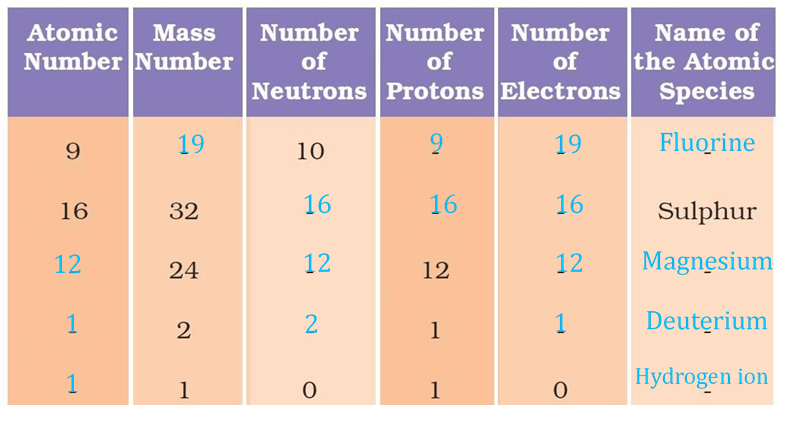NCERT Solutions for Class 9 Science (Chemistry) Chapter 4 Structure of the Atom provides detailed answers for all in-text and exercise Questions. These solutions contain an in-depth explanation of each topic involved in the chapter. All these solutions are prepared by expert teachers and updated for the current academic session.
NCERT Solutions for Class 9 Science (Chemistry) Chapter 4 Structure of the Atom Pure help students to understand the fundamental concepts given in class 9 Science textbook. We have prepared the answers to all the questions in an easy and well-structured manner. It helps students to grasp the chapter easily.
CBSE Class 9 Science Structure of the Atom Intext Questions (Solved)
PAGE NO – 39
Question 1: What are canal rays?
Answer: Canal rays are positively charged radiations. These rays consist of positively charged particles known as protons. They were discovered by Goldstein in 1886.
Question 2: If an atom contains one electron and one proton, will it carry any charge or not?
Answer: If an atom contains one electron and one proton, it will not carry any net charge. This is because a proton has a positive charge and an electron has a negative charge, and these two charges are equal in magnitude but opposite in sign. In such an atom, the positive charge of the proton and the negative charge of the electron will cancel each other out, resulting in a neutral overall charge. An example of such an atom is hydrogen, which typically has one proton and one electron in its most common form.
PAGE NO. 41
Question 1: On the basis of Thomson’s model of an atom, explain how the atom is neutral as a whole.
Answer: According to Thomson’s model of the atom, an atom consists of both negatively and positively charged particles. The negatively charged particles are embedded in the positively charged sphere. These negative and positive charges are equal in magnitude. Thus, by counterbalancing each other’s effect, they make an atom neutral.
OR
According to Thomson’s model, an atom is neutral because it contains an equal amount of positive and negative charges that balance each other out. In this model, the atom is like a positively charged sphere with negatively charged electrons embedded in it. The positive charge is spread out over the entire sphere, and the electrons are placed within this sphere. Since the number of negative charges (electrons) equals the number of positive charges in the sphere, the overall charge of the atom is neutral. This balance of equal and opposite charges ensures that the atom does not have a net charge.
Question 2: On the basis of Rutherford’s model of an atom, which subatomic particle is present in the nucleus of an atom?
Answer: On the basis of Rutherford’s model of an atom, protons (positively-charged particles) are present in the nucleus of an atom.
Question 3: Draw a sketch of Bohr’s model of an atom with three shells.
Answer:
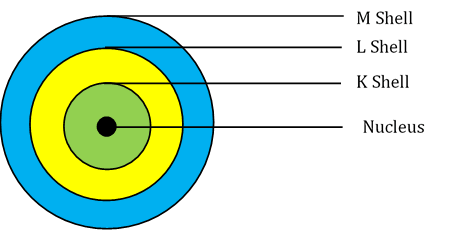
Question 4: What do you think would be the observation if the α-particle scattering experiment is carried out using a foil of a metal other than gold?
Answer: If the α-scattering experiment is carried out using a foil of metal rather than gold, there would be no change in the observation. In the α-scattering experiment, a gold foil was taken because gold is malleable and a thin foil of gold can be easily made. It is difficult to make such foils from other metals.
PAGE NO. 41
Question 1: Name the three sub-atomic particles of an atom.
Answer: The three sub-atomic particles of an atom are:
- Protons
- Electrons, and
- Neutrons
Question 2: Helium atom has an atomic mass of 4 u and two protons in its nucleus. How many neutrons does it have?
Answer: Helium atom has two neutrons. The mass of an atom is the sum of the masses of protons and neutrons present in its nucleus.
Since helium atom has two protons, mass contributed by the two protons is (2 × 1) u = 2 u. Then, the remaining mass (4 − 2) u = 2 u is contributed by 2u /1u = 2 neutrons.
PAGE NO. 42
Question 1: Write the distribution of electrons in carbon and sodium atoms?
Answer: The total number of electrons in a carbon atom is 6. The distribution of electrons in carbon atom is given by:
| First orbit or K-shell | = 2 electrons |
| Second orbit or L-shell | = 4 electrons |
Or,
we can write the distribution of electrons in a carbon atom as 2, 4.
The total number of electrons in a sodium atom is 11. The distribution of electrons in sodium atom is given by:
| First orbit or K-shell | = 2 electrons |
| Second orbit or L-shell | = 8 electrons |
| Third orbit or M-shell | = 1 electron |
Or,
we can write distribution of electrons in a sodium atom as 2, 8, 1.
Question 2: If K and L shells of an atom are full, then what would be the total number of electrons in the atom?
Answer: The maximum number of electrons that can occupy K and L-shells of an atom are 2 and 8 respectively. Therefore, if K and L-shells of an atom are full, then the total number of electrons in the atom would be (2 + 8) = 10 electrons.
PAGE NO. 43
Question 1: How will you find the valency of chlorine, sulphur and magnesium?
Answer: If the number of electrons in the outermost shell of the atom of an element is less than or equal to 4, then the valency of the element is equal to the number of electrons in the outermost shell.
On the other hand, if the number of electrons in the outermost shell of the atom of an element is greater than 4, then the valency of that element is determined by subtracting the number of electrons in the outermost shell from 8.
The distribution of electrons in chlorine, sulphur, and magnesium atoms are 2, 8, 7; 2, 8, 6 and 2, 8, 2 respectively. Therefore, the number of electrons in the outermost shell of chlorine, sulphur, and magnesium atoms are 7, 6, and 2 respectively.
Thus,
The valency of chlorine = 8 −7 = 1
The valency of sulphur = 8 − 6 = 2
The valency of magnesium = 2
PAGE NO. 43
Question 1: If number of electrons in an atom is 8 and number of protons is also 8, then
(i) what is the atomic number of the atom and
(ii) what is the charge on the atom?
Answer: (i) The atomic number is equal to the number of protons. Therefore, the atomic number of the atom is 8.
(ii) Since the number of both electrons and protons is equal, therefore, the charge on the atom is 0.
Question 2: With the help of Table 4.1, find out the mass number of oxygen and sulphur atom.
Answer: Mass number of oxygen = Number of protons + Number of neutrons = 8 + 8 = 16
Mass number of sulphur = Number of protons + Number of neutrons = 16 +16 = 32
PAGE NO. 45
Question 1: For the symbol H, D and T tabulate three sub – atomic particles found each of them.
Answer:
| Symbol | Proton | Neutron | Electron |
| H | 1 | 0 | 1 |
| D | 1 | 1 | 1 |
Question 2: Write the electronic configuration of any pair of isotopes and isobars.
Answer: Isotopes: Isotopes are atoms which have the same number of protons but the number of neutrons differs. This leads to the variation in mass number too.
Two isotopes of carbon are 6𝐶12 and 6𝐶14
The electronic configuration of 6𝐶12 is 2, 4.
The electronic configuration of 6𝐶14 is 2, 4.
[Isotopes have same electronic configuration]
Isobars: Isobars are atoms which have the same mass number but differ in the atomic number. Electronic configuration of an isobar pair is as follows,
29Ca40 and 8𝐴𝑟40 are a pair of isobars of calcium.
The electronic configuration of 29Ca40 is 2, 8, 8, 2
The electronic configuration of 18𝐴𝑟40 is 2, 8, 8.
[Isobars have different electronic configuration]
NCERT Class 9 Science Structure of the Atom Exercise Questions (Solved)
Question 1: Compare the properties of electrons, protons and neutrons.
Answer:
| Electron | Proton | Neutron |
| (i) Electron are present outside the nucleus of an atom. | (i) Proton are present in the nucleus of an atom. | (i) Neutron are present in the nucleus of an atom. |
| (ii) Electron are negatively charged | (ii) Proton are positively charged. | (ii) Neutron are neutral. |
| (iii) The mass of an electron is considered to negligible. | (iii) The mass of a proton is approximately 2000 times as the mass of an electron | (iii) The mass of neutron is nearly equal to the mass of a proton. |
Question 2: What are the limitations of J.J. Thomson’s model of the atom?
Answer: J.J. Thomson’s model of the atom, known as the “plum pudding model,” had a few key limitations:
1. According to J.J. Thomson’s model of an atom, an atom consists of a positively charged sphere with electrons embedded in it. However, later Rutherford’s gold foil experiment showed that the positively charged particles reside at the center of the atom called the nucleus, and the electrons revolve around the nucleus.
2. Thomson’s model was unable to explain many chemical properties of elements, such as why atoms combine in fixed ratios to form compounds.
3. It didn’t clearly distinguish between the nucleus and the rest of the atom, and couldn’t explain why atoms are stable.
Question 3: What are the limitations of Rutherford’s model of the atom?
Answer: According to Rutherford’s model of an atom, electrons revolve around the nucleus in fixed orbits. But, an electron revolving in circular orbits will not be stable because, during the revolution, it will experience acceleration. Due to acceleration, the electrons will lose energy in the form of radiation and fall into the nucleus. In such a case, the atom would be highly unstable and collapse.
Question 4: Describe Bohr’s model of the atom.
Answer: Bohr’s model of the atom Niels Bohr proposed the following postulates regarding the model of the atom.
- Only certain orbits known as discrete orbits of electrons are allowed inside the atom.
- While revolving in these discrete orbits, the electrons do not radiate energy. These discrete orbits or shells are shown in the following diagram.
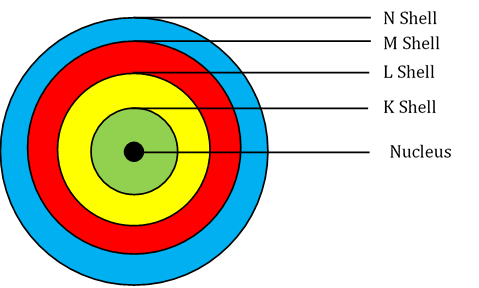
The first orbit (i.e., for n = 1) is represented by letter K. Similarly, for n = 2, it is L − shell, for n = 3, it is M − shell and for n = 4, it is N − shell. These orbits or shells are also called energy levels.
Question 5: Compare all the proposed models of an atom given in this chapter.
Answer:
| Thomson’s model | Rutherford’s model | Bohr’s model |
| An atom consists of a positively charged sphere with electrons embedded in it. | An atom consists of a positively charged particles concentrated at the center known as the nucleus | There are only certain orbits know as discrete orbits inside the atom in which electrons revolve around the nucleus. |
| Positively charge is equal to negatively charge. | The electron revolve around the nucleus in well – defined orbits. | Electrons do not radiate energy while revolving |
| The net charge in the atom is zero. | The size of the nucleus is very small as compared to the size of the atom. | The distinct orbits are labelled as K, L, M, N |
Question 6: Summarize the rules for writing of distribution of electrons in various shells for the first eighteen elements.
Answer: The rules for writing of the distribution of electrons in various shells for the first eighteen elements are given below:
(i) The maximum number of electrons that a shell can accommodate is given by the formula ‘2n2‘, where ‘n’ is the orbit number or energy level index (n = 1, 2, 3…).
Now, Maximum number of electrons in different shells are:
K shell n = 1: 2n2 = 2(1)2 = 2
L shell n = 2: 2n2 = 2(2)2 = 8
M shell n = 3: 2n2 = 2(3)2 = 18
N shell n = 4: 2n2 = 2(4)2 = 32
(ii) The outermost orbit can be accommodated by a maximum number of 8 electrons.
(iii) Shells are filled with electrons in a step-wise manner i.e., the outer shell is not occupied with electrons unless the inner shells are completely filled with electrons.
Question 7: Define valency by taking examples of silicon and oxygen.
Answer: Valency is the measure of the ability of an atom to combine with other atoms. It is determined by the number of electrons an atom can lose, gain, or share to become stable.
- Example with Silicon: Silicon has 4 electrons in its outermost shell. It can share these 4 electrons with other atoms to complete its outer shell, typically holding 8 electrons. So, the valency of silicon is 4, as it can form bonds by sharing 4 electrons.
- Example with Oxygen: Oxygen has 6 electrons in its outer shell. It needs 2 more electrons to complete its shell. So, it can either gain 2 electrons or share 2 electrons with other atoms. Therefore, the valency of oxygen is 2.
Question 8. Explain with examples:
(i) Atomic number
(ii) Mass number,
(iii) Isotopes and
(iv) Isobars.
Give any two uses of isotopes.
Answer:
(i) Atomic number: The atomic number of an element is the total number of protons present in the atom of that element. For example, nitrogen has 7 protons in its atom. Thus, the atomic number of nitrogen is 7.
(ii) Mass number: The mass number of an element is the sum of the number of protons and neutrons present in the atom of that element. For example, the atom of boron has 5 protons and 6 neutrons. So, the mass number of boron is 5 + 6 = 11.
(iii) Isotopes: They are atoms of the same element and have same atomic number but different mass number/atomic mass. For example: C12 and 6C14
(iv) Isobars: They are atoms of different elements having same mass number but different atomic number. For example calcium, atomic number 20 and argon, atomic number 18. The number of electrons in these atoms is different, but the mass number of both these elements is 40. That is, the total number of neutrons is the same in the atoms of this pair of elements.
Two uses of isotopes are as follows:
- An isotope of uranium is used as a fuel in nuclear reactors.
- An isotope of cobalt is used in the treatment of cancer.
Question 9: Na has completely filled K and L shells. Explain.
Answer: Na has atomic number 11, so its electronic configuration is = 2, 8, 1
Sodium atom (Na) looses 1 electron to become stable and form Na+ ion. so its electronic configuration is = 10 = 2, 8.
The above configuration indicates completely filled K, L shells.
Question 10: If bromine atom is available in the form of, say, two isotopes 35𝐵𝑟79 (49.7%) and 35𝐵𝑟81 (50.3%), calculate the average atomic mass of bromine atom.
Answer: The average atomic mass of bromine
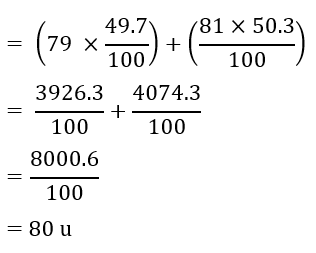
Question 11. The average atomic mass of a sample of an element X is 16.2 u. What are the percentages of isotopes 168X and 188X in the sample?
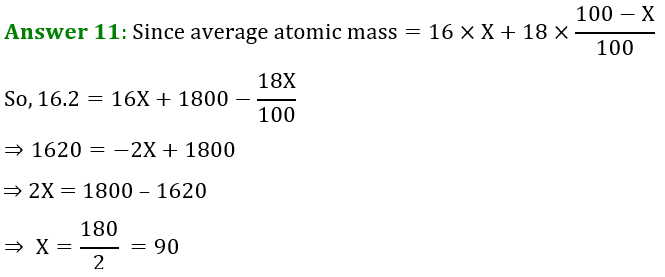
Question 12: When 90% is the X-16 sample so for X-18 sample % = 100-90=10% If Z = 3, what would be the valency of the element? Also, name the element.
Answer: By Z = 3, we mean that the atomic number of the element is 3. Its electronic configuration is 2, 1. Hence, the valency of the element is 1 (since the outermost shell has only one electron).
Therefore, the element with Z = 3 is lithium.
Question 13: Composition of the nuclei of two atomic species X and Y are given as under
| X | Y | |
| Protons = | 6 | 8 |
| Neutrons = | 6 | 8 |
Give the mass numbers of X and Y. What is the relation between the two species?
Answer: Mass number of X = Number of protons + Number of neutrons = 6 + 6 = 12
Mass number of Y = Number of protons + Number of neutrons = 6 + 8 = 14
These two atomic species X and Y have the same atomic number, but different mass numbers. Hence, they are isotopes.
Question 14. For the following statements, write T for true and F for false.
(a) J.J. Thomson proposed that the nucleus of an atom contains only nucleons.
(b) A neutron is formed by an electron and a proton combining together. Therefore it is neutral.
(c) The mass of an electron is about 1/2000 times that of proton.
(d) An isotope of iodine is used for making tincture iodine, which is used as a medicine.
Solution:
(a) False
(b) False
(c) True
(d) False
Put a tick(✓) against correct choice and cross(x) against wrong choice in questions 15, 16 and 17.
Question 15. Rutherford’s alpha-particle scattering experiment was responsible for the discovery of
(a) Atomic nucleus
(b) Electron
(c) Proton
(d) Neutron
Answer: (a) Atomic nucleus
Question 16. Isotopes of an element have
(a) The same physical properties
(b) Different chemical properties
(c) Different number of neutrons
(d) Different atomic numbers.
Answer: (c) Different number of neutrons
Question 17. Number of valence electrons in Cl− ion are:
(a) 16
(b) 8
(c) 17
(d) 18
Answer: (b) 8
Electronic distribution of Cl is K-2, L-8, M-7. Valence electrons are 7, hence chlorine gains one electron for the formation of Cl–. Therefore, its valency is 8.
Question 18. Which one of the following is a correct electronic configuration of Sodium?
(a) 2, 8
(b) 8, 2, 1
(c) 2, 1, 8
(d) 2, 8, 1
Answer: (d) 2, 8, 1
Question 19: Complete the following table.
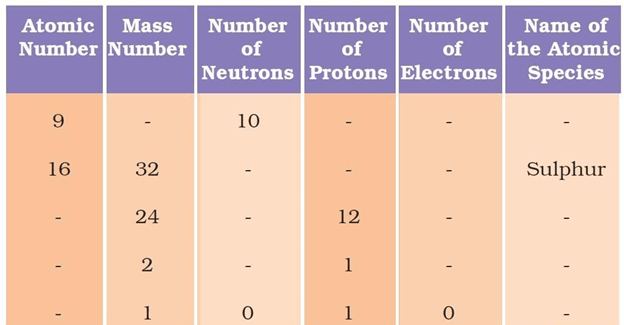
Answer: The following table depicts the missing data:
Atomic number(Z) =Number of protons
Mass number = Number of neutrons + atomic number
(or)
Mass number(A) = Number of neutrons + number of neutrons
